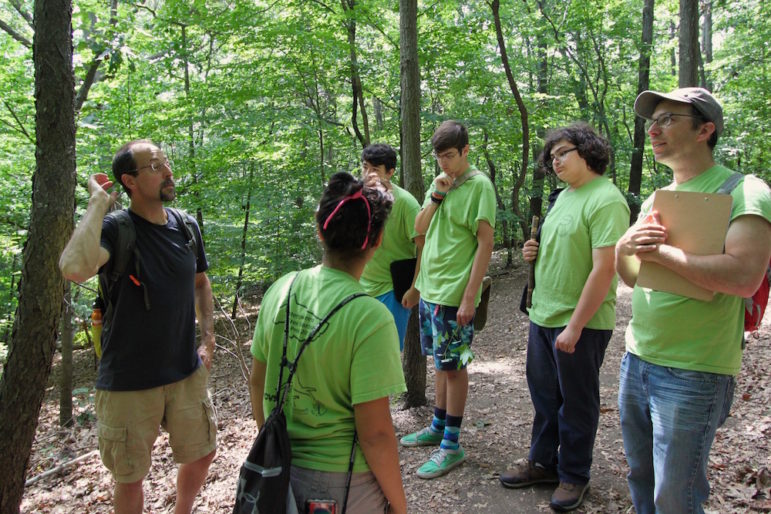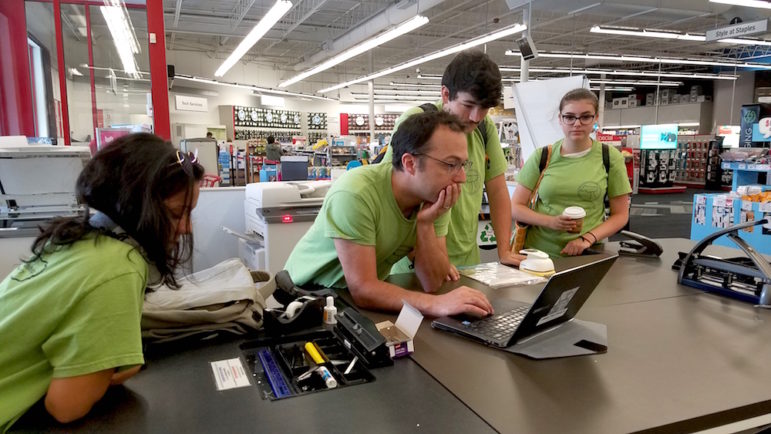
Charlie Breitrose
The Watertown Teen Tree Stewards learn about Watertown’s Whitney Hill, the only piece of wild forest left in town, from Andy Hinton of the Nature Conservancy, left.
Half a dozen young nature enthusiasts have taken to the streets of Watertown this summer with a mission of caring for the town’s street trees and spreading the word about the importance of urban trees.
The six teens are part in the Watertown Teen Tree Stewardship Program, which is sponsored by Trees for Watertown, a citizens group committed to protecting and promoting trees in town.
Each day, the group has an activity. Sometimes it is looking around town for street trees that are in need of help, other times it is learning about trees and nature, and sometimes they are promoting their program, said David Meshoulam, founder and coordinator of the program.
As Meshoulam drives the group around town, the former Newton North High School science teacher points out a “beautiful beech” or a tree that has not been properly planted.
The teens have been keeping track of trees around town.
“We see how the trees looks, and if it is not looking good or is discolored we write a report about it,” said WHS junior Trevor Russo.
Junior Miles Hohmann said he was taught to spot if a tree is rotting or if is has been impacted by pests.
They keep a close eye on trees that could pose threaten public safety.
“If we see a tree that we think will fall down, we will contact the Tree Warden immediately,” said sophomore Lila Cherry-German.
The teens also learned about how to plant trees, and can point out ones that have not been done correctly. Senior Nezzi Da Silva said that trees should be planted with a saucer shaped mulched area around the trunk.
“If you have a saucer it will pool water and help the tree grow,” Da Silva said.
When young, trees need quite a bit of attention, Meshoulam, but as they get older they can thrive with out a great deal of care.
“We mainly look at newer trees. We update (the Town’s) inventory on the condition,” Meshoulam said.
Junior Marco Libertini said he has enjoyed being part of the program.
“I have always been interested in trees and this has increased that by a good amount,” Libertini said.
The group is also collecting a list of people’s favorite trees around town, and created a Google map to document where they can be found. People can email their favorite trees, along with an address and the type of tree (if you know it) to treesforwatertownma@gmail.com or direct message (DM) them on Instagram to @watertowntrees. The map can be seen at bit.ly/watertowntrees.
Meshoulam left Newton North and is looking for a way to combine two of his loves – working with young people and urban trees. He started the Teen Tree Stewardship Program as a pilot program. He hopes that the teens learn not only about trees, but skills such as critical thinking and problem solving – things that he does not always get taught in schools today.
“The work we are doing is important for what they will do with their lives. Kind of like a tree,” Meshoulam said. “It takes 20 years to grow a tree, and the early years are key to establishing a tree.”
Some days, the group has special guests or takes field trips. The teens visited the Harvard Herbarium and the Harvard Natural History Museum, and plan to visit the Harvard Forest in Petersham, near the Quabbin Reservoir in Worcester County.
They also got a tour of Watertown’s own slice of forest – Whitney Hill. They were lead by Andy Finton, a town resident who works for the Nature Conservancy.
Finton told the group about invasive species that can be found in New England forests, including trees such as the Norway Maple and plants such as Asiatic bittersweet, which will damage other plants.
“Look at the bittersweet growing up this young tree,” Finton said, pointing to a green vine that curled its way up the small trunk.

Charlie Breitrose
Members of the Watertown Teen Tree Stewardship Program work at Staples with coordinator David Meshoulam, in the foreground, to create brochures about the program to give out at the Watertown Farmers Market.
Finton also taught the young tree enthusiasts that care of trees can be different in a forest than for an urban street tree. The teens were taught to prune off the “suckers” or fledgling limbs, that appear low down on street trees. Finton said that is not what to do in a forest.
“There is probably disease in the bark, causing the twisted bark,” Finton said. “It is trying to help itself by starting new suckers.”
In a street tree, on the other hand, the suckers would take away from more mature limbs, Meshoulam said, plus there are regulations that there should be no limbs below 8 feet above the ground.
Finton said that places like Whitney Hill, or even a tree on the street, are important for cooling the town in the summer.
“It is not just trees right over a house, but one in the neighborhood,” Finton said. “The air is cooler and blows into the neighborhood.”
The Teen Tree Stewards learn more than just about trees. They also promoted their program at the Watertown Farmers Market, and designed the brochures and stickers handed out at the market.
The program is a paid internship for the teens. They will be paid $1,000 for 120 hours of work over a seven week period. The students can also earn community service hours that are a graduation requirement at Watertown High School.
Meshoulam received $6,000 in grants from the Watertown Community Foundation – $2,000 for experts and supplies and funding for four internships through the WCF’s student internship program. Trees for Watertown also donated $2,000 for internships.
The program is a labor of love for Meshoulam, who said he is not being paid a real salary this summer to run the program.
“It is mainly volunteer for me,” Meshoulam said. “I am trying to figure out a way how to make it sustainable.”
He is not sure yet whether the program will continue in future years, but he hopes to do so and expand to other communities so he can promote the importance of urban trees.

Congratulations David and our Teen Tree Stewards. Thank you from all of us in Watertown who know how important it is to have a green city.
Would love to have them check the town-planted Sargent Cheery tree in
front of our home at 14 Myrtle. THE TREE IS BADLY INFECTED AND DYING.
We have done everything recommended to preserve this tree during the past 21
months. We were told not to spray to treat the current fungal infection.
So sad.
Please reach out to Chris Hayward, the tree warden, at chayward@watertown-ma.gov. I’ll make sure that we come visit the tree this week or next. Unfortunately, mortality rate for newly planted trees (2-3 years) is very high, especially after the drought we had.
-David Meshoulam
It’s wonderful that these young Watertown residents have the opportunity to “think like trees” for a summer. Factors related to climate change, such as drought, severe weather and invasive species are having a negative impact on trees in New England. This innovative program will help bring new awareness to the value — and the fragility — of our urban tree canopy.
This program sounds wonderful: A great learning experience for students whom hopefully later in life will. Ecome tree stewards and spread the word about the importance of urban trees to the quality of life in municipalities. These students can also be a great help by inventorying the yrban forest in Watertown. I would love to duplicate this procram in Rhinebeck, NY where I live.
I am proud of the work Trees for Watertown continues to do to enlarge and protect the urban forest of water and to pass their enthusiasm for tree to the next generation!!! Sincely, Meg Crawford , one of original founders of TFW some30 yrs. ago
Thanks for your supportive comment, Meg. I’d love to connect sometime. You can reach me at david.meshoulam at gmail. Thanks for founding TFW!